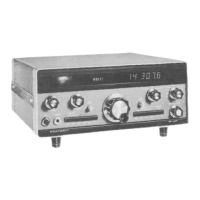Page 240
1,
(\j)
Refer to Figure 1-8A (fold-out from this page) and
( )
Tune the Tranxziver to 3500 kHz and select the
solder the free lead of the 18
pF capacitor to the foil strongest signal within one-half of a tuning knob
designated TP on circuit board A. Solder the cable
revolution.
~lr
,
y
,..
t~
bP
.A
shield wires to the ground foil in the area shown.
(
)
Pull circuit board D up just enough to clear the
(kl
Carefully ~lua board A back into
its
comoartment.
connectors on the board's bottom edge
.
-
Look between the foil side of the circuit board and
(
Write
down
the
S.meter
reading,
the shield to make sure the "hot" lead of the capacitor
does not touch the shield.
(
I
Push circuit board
D
back down onto
its
connectors.
(,%$'
Replace the phono plug in 5101.
(30
Remove circuit board G from theTransceiver.
()o
Refer to Figure 1-86 and carefully unsolder from
circuit board G the end of the jumper marked "this
end." Pull the end of the jumper out of the circuit
board hole.
(H
Position the end of the center conductor of the
shielded cable coming from circuit board A alongside
the end of the jumper and solder the two together.
Use
a minimum amount of solder. Bend the shield
wires out of the way.
( )
Install the extender board in position
G.
77
r\<>
A',:
<5.
.-,':,
,$%,
?,.W
(
)
Install circuit board G in the extender board.
(
)
Set the front panel controls as follows:
Band Switch 3.5
1
RF Gain Fully clockwise
mtJ
'j
ALC button Depressed
USB button Depressed
AGC Fast
IMPORTANT: ALWAYS turn the Transceiver OFF before
you insert or remove a circuit board.
( )
Depress the ON button.
(
1
Adjust the AF GAlN mntrol for
a
comfortable
listening level.
\G
,;
!
(4:
:,
c,
.uc*4:,,
(
)
Tune the Transceiver to 3800 kHz. Then select the
strongest signal within 5 kHz of this frequency.
When you perform any of the alignment steps in the
remainder of this Manual,
keep
the S-meter below a full
scale indication by adjustment of the
S-Meter Level Adjust
control on circuit board
F
(see Figure 1-3, fold-out from
Page 237). DO NOT use the RF
GAlN control for this
purpose.
(
)
Set the S-METER LEVEL ADJUST mntrol, (see
Figure
1-3, fold-out from Page 237) for an Smeter
reading of S9+50.
100
x:/5
ti",
I,",.':<
(
1
Tune the Transceiver to 4000 kHz and select the
strongest signal within one-half of a tuning knob
revolution.
( )
Pull circuit board D up just enough to clear the
connectors on the board's lower edge.
( )
Write down the S-meter reading.
(
)
Repeat the above procedures
at
3500 kHz and 4000
kHz and simultaneously adjust the trimmer capacitors
on coils L725 and L726 until the two
S-meter readings
are as close together as you can conveniently get them.
The readings will probably never coincide exactly.
Two or three repetitions of the adjustment should be
adequate.
(
)
Remove the shielded cable from the jumper on circuit
board G.
I
)
Reinstall the free end of the jumper on circuit board G
in
its
former position (S-1).
NOTE: If you will perform the "Preselector Bandpass Filter
Alignment" immediately, disregard the following two steps
and leave the extender board and circuit board G in position
G.
( )
Remove circuit board G from the extender board and
the extender board from position G.
( )
Reinstall circuit board G in position
G.
( )
Reinstall circuit board D.
NOTE: The shielded cable connected to circuit board A will
be used in the
fotlowing bandpass filter alignment steps.
PRESELECTOR BANDPASS
FILTER ALIGNMENT
The object of this procedure
is
to adjust each bandpass filter
for
a
uniform response across
its
frequency range. One filter
is
used for each of the 80.40, 20, and 15 meter bands. Two
filters are used for the 10 meter band, one for the 28.0 and
28.5 band switch positions. and one for the 29.0 and 29.5
positions. The alignment of
a
filter calls for
a
coarse
adjustment to a center
ferquency, followed by equalizing
adjustments
at
the band edges. Although the band edge
responses will not be exactly equal, they will be reasonably
dose.

